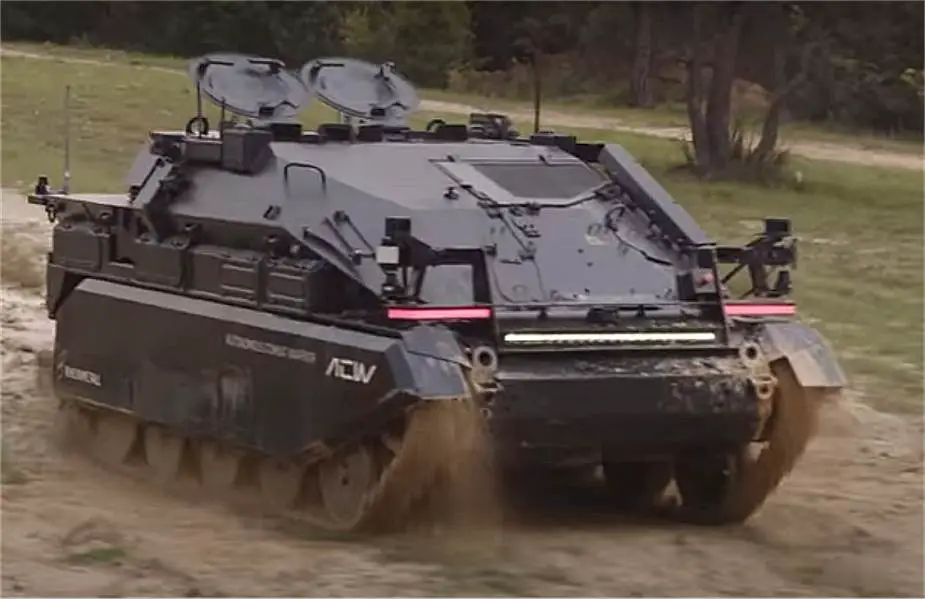Rheinmetall from Germany develops Wiesel 2 light tracked armored in autonomous variant
According to a video published by the German company Rheinmetall on December 10, 2021, Rheinmetall Defense continues to develop and test an autonomous version of its Wiesel 2 light airborne tracked armored vehicle, called Autonomous Combat Warrior Wiesel (ACW).
Follow Army Recognition on Google News at this link

New Wiesel 2 Autonomous Combat Warrior. (Picture source Rheinmetall Youtube)
The German company Rheinmetall Defence is one of the global leaders in the development and the production of combat and tactical vehicles and has now developed a full range of new generations of robotic, remote and autonomous combat vehicles based on tracked or wheeled chassis.
The Wiesel 2 is a light armored air-transportable vehicle, that was developed by Rheinmetall that entered into service with the German army in 1995. The Wiesel 2 was used as a universal platform to develop a whole family of combat vehicles including command post, medical evacuation vehicle, radar carrier, reconnaissance vehicle, NBC vehicle, and weapons platforms.
In October 2019, Rheinmetall Defense has exhibited its robotic combat solution “Wiesel Wingman” autonomous combat vehicle concept for the US Army Robotic Combat Vehicle – Light program at AUSA 2019, a defense exhibition in Washington D.C., United States. The vehicle was based on the Wiesel light airborne tracked armored vehicle.
The Wiesel Wingman is based on Rheinmetall’s Wiesel Digital, a fully digitalized version of the Wiesel that has been refined over the past years. This includes the full digitalization of the vehicle and the replacement of all mechanical and hydraulic transmission elements with a digitized transmission.
The Wiesel Digital was developed by Rheinmetall Defense to offer a new unmanned solution able to conduct a wide range of missions such as command and control as well as reconnaissance. The vehicle was fully digitized and fitted with a vetronics architecture and a range of specialized sensors. It is also equipped with a navigation and global positioning system, air conditioning, a total of two control handles, five joysticks, and six displays. It is operated by a crew of three (driver, observer, and commander) and in hazardous conditions can be operated by remote control.

Wiesel Wingman Robotic Combat Vehicle at AUSA 2019 defense exhibition in Washington D.C. (Picture source Army Recognition)
The Wiesel Wingman is equipped with Drive by Wire (DbW) with triple redundancy. This DbW system has gone through rigorous testing, making the Wiesel Wingman the very first armored tracked vehicle certified for on-road use with DbW. The vehicle retains the high mobility found in existing variants of the Wiesel, with a top speed of 43mph and excellent maneuverability on various terrain due to its low GVW and low ground pressure.
The Wiesel Wingman armored hull protects all critical components against fragmentation and small arms fire. The vehicle can be equipped with a variety of systems; for the RCV-L the Wiesel Wingman includes a CROWS-J; other lethal variants are also possible, based on the payload capability of the Wiesel chassis. The vehicle has outstanding reconnaissance capabilities due to its superior mobility and its integrated tethered drone, which highly increases its surveillance and target identification capabilities. The Wiesel Wingman can be air-transported in a CH-47 and a CH-53 as an internal or external load. Two of the vehicles can easily fit into a C-130. This vehicle has been tested and proven during various exercises and trials by the US and German Army.

German army Wiesel 2 light tracked airborne armored vehicle.
Rheinmetall has now developed a new version, the Autonomous Combat Warrior Wiesel (ACW) offering a new generation of an unmanned armored vehicle equipped with a state of the art autonomous kit which is applicable to a variety of both tracked and wheeled vehicle systems such as Boxer, Lynx or HX tactical trucks.
The ACW can be operated manually, remote-controlled, or in fully autonomous mode by programming waypoints on a tablet. It can avoid obstacles autonomously and it can also follow a lead vehicle in convoy mode. Next-generation features include detecting soldier behavior and off-road terrain. The ultimate goal is to improve soldier safety by keeping operators out of harm’s way.



























